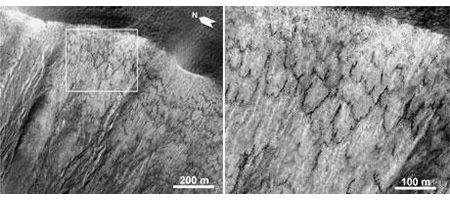Parts of Mars appear to have been modified by liquid water comparatively recently, indicating that there may have been favorable conditions for life.

A new study by an international team of researchers shows that large areas of the northern hemisphere have undergone a number of freeze-thaw cycles.
“This process is common in our own Arctic permafrost environments and causes the formation of lobate features on slopes,” says Andreas Johnsson at the University of Gothenburg’s Department of Earth Sciences.
“As the Martian landscapes we’re studying feature ground-ice, our interpretation is that liquid water has been available in the ground during thaw periods.”
Scientists have long been aware of relatively young gullies on Mars, which appear to have been formed by liquid water when ice melted and the near-surface sediment on the slopes became saturated with the melt water and slowly began to slide downwards.
“Our question was: if liquid water can occur in local niches, predominantly in impact craters, where most of the gullies are to be found, then shouldn’t we see more signs of thawing and the effects of melt water, along the lines of those in our own Arctic environments?” says Johnsson.
His team discovered features known as solifluction lobes close to the gullies – similar to those found in Arctic areas on Earth.
“Unlike local ice-melting, as suggested by the ravines, the solifluction lobes indicate that there has probably been more widespread thawing of the Martian landscape,” says Johnsson.
“Consequently there must have been liquid water in large areas, which is interesting for our understanding of past climates.”
Indeed, either the climate models for Mars must be fine-tuned to include the climatic conditions required by these features, or there’s something else going on.
Since the Mars Phoenix Lander mission, it’s been known that the ground contains salts that can affect the freezing point of water on Mars so that it can be liquid even at sub-zero temperatures and low atmospheric pressure.
“We don’t yet know which of these scenarios is more likely − it could be a combination of the two,” says Johnsson.
Research has shown that organisms can survive for long periods without water in cold environments on Earth – but that there must be access to water at times.






